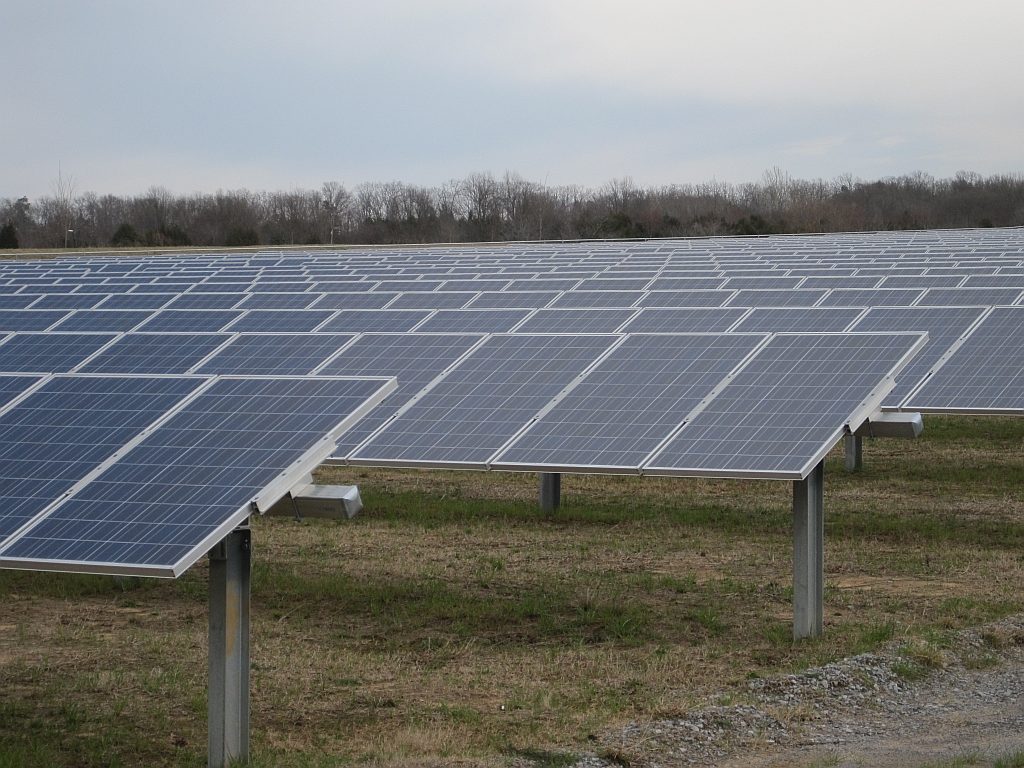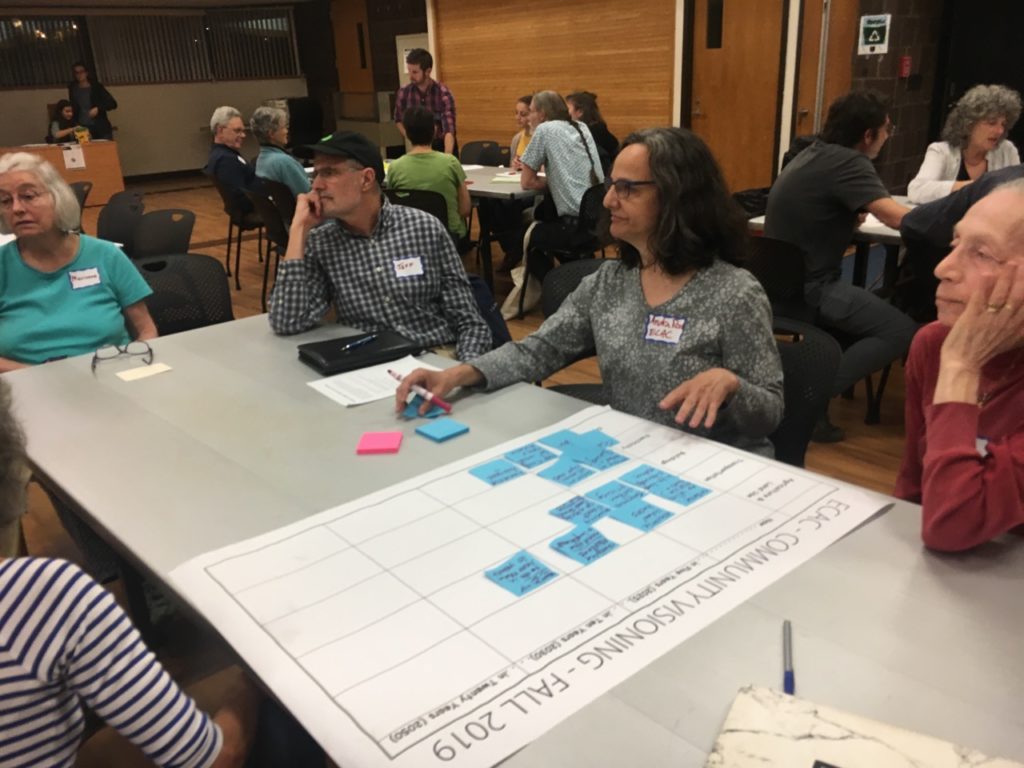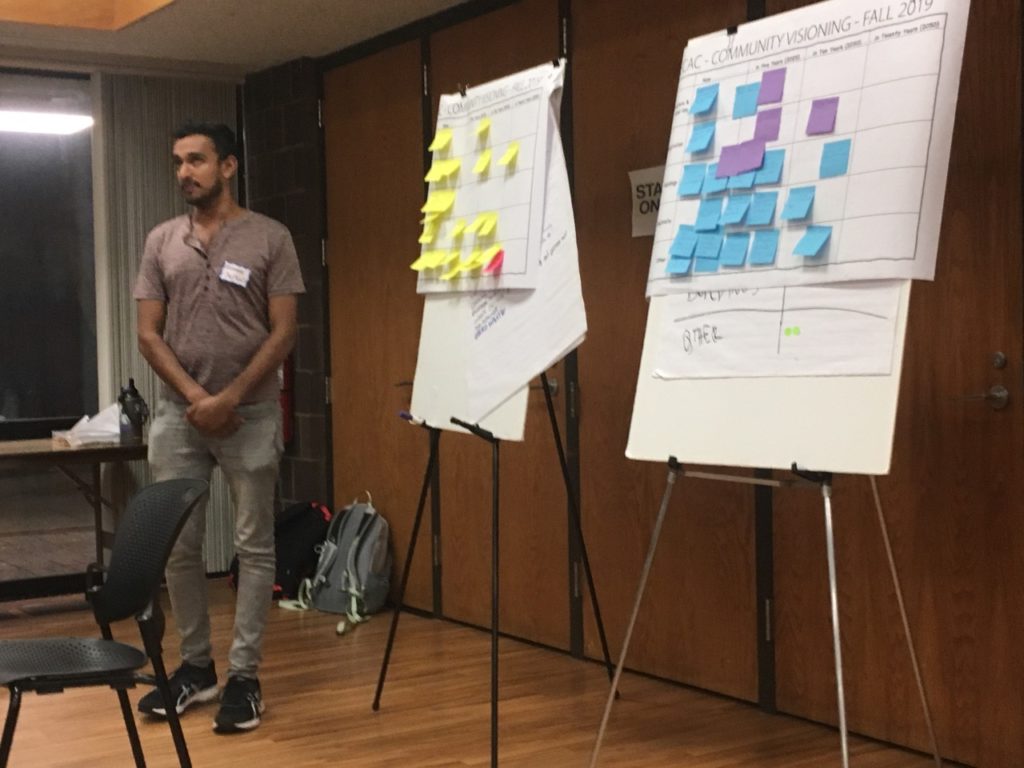ENERGY COMMITTEE HOLDS FIRST PUBLIC VISIONING SESSION ON TOWN’S CLIMATE MITIGATION GOALS

Solar Farm. Photo:commons.wikimedia.org.
Twenty-five people gathered at the Bangs Center on Wednesday evening (10/2) for the first of two public visioning sessions sponsored by the town’s Energy and Climate Action Committee (ECAC). The forum was part of an ECAC outreach program aimed at taking the pulse of the town concerning climate issues and renewable energy. The committee seeks to learn about the ways in which climate change has impacted residents and would like to hear their concerns, ideas, visions, hopes, and possible strategies for the town. The information gathered will inform the committee’s formulation of energy goals for the town that will be presented to the Town Council in late November.
A second public forum will be held from 10 a.m. until noon on Saturday (10/5) in the Woodbury Room of the Jones Library. This event is free and open to the public, and childcare will be provided.
The evening opened with a welcome from Laura Draucker, chair of ECAC. She reviewed the mission of the ECAC and the challenges that the Committee faces in guiding the town in
developing and executing climate mitigation goals. Draucker reminded those present that the goals we need to achieve are pretty clear and are well supported by science community: We need to cut global greenhouse emissions by half in the next ten years and by 100 percent by 2050. She added that there is an increasingly broad call for this worldwide.
Draucker then asked those present to consider how energy challenges might play out across five sectors in Amherst: emissions,, heating and cooling, new buildings, transportation, and agriculture. She reminded participants that our most vulnerable communities will be the most impacted by climate change and that we need to keep that in mind as we formulate policy. She concluded, “We need creative, flexible, solutions to bring us to a just transition away from fossil fuels.”
Two activities followed. In the first, people were paired off and asked to explain to each other why they had come to this meeting and what issues they thought the ECAC ought to address.
In the second activity, participants were divided into three groups, each facilitated by an ECAC member. The groups undertook a visioning exercise in which people shared their ideas about energy goals for Amherst, how to address those goals, and creating a “time-line” identifying which goals should be addressed immediately and which could be better or more fully addressed over a longer time frame, e.g. between five and thirty years.

The groups dove into the task with enthusiasm, coming up with dozens of suggestions which they placed along the timeline.

Among the suggested energy goals were:
- A light rail or trolley connecting the five colleges (or at least UMass and Hampshire College)
- Town of Amherst using 100 percent renewable energy by 2030, joining ninety communities and nine states that have made the commitment to achieve this goal between 2020 and 2050.
- Community shared electricity consortium
- Improved and decarbonized mass transit
- Make Amherst more bike and pedestrian friendly
- Green energy board as part of town government
- Infuse all critical town committees with climate consciousness an awareness of the climate emergency, and a commitment to climate mitigation goals. All boards embrace town’s energy goals and formulate policy accordingly.
- Get the three colleges on board (noting that Amherst and Hampshire have already committed to 100 percent renewable energy)
- Address methane emission at landfill
Town Councilor Evan Ross (District 4), a member of ECAC, noted that the groups tended to emphasize what we need to do now because if we don’t do that, we are not going to be able to address the long-term needs. .
Several participants said they anticipate resistance in Amherst to the list of suggestions because of financial considerations but noted that it is imperative that the town consider the future costs of not doing them now.
The organizers were enthusiastic about the turnout and the level of participation. Druacker said, “It was great! We heard a lot of innovative ideas and I really liked how two of the tables suggested that ECAC’s goals need to be integrated into all of the departments in town. That’s one that we’re going to have to take back and work on.”
Amherst Sustainability Coordinator Stephanie Ciccarello said, “It was a great turnout. We had incredible conversations and heard incredible, innovative ideas. It was very inspiring and I feel very hopeful.”

Hi everybody,
As much as I’d love light rail in the Amherst area, we already have many of the needed local transportation tools – if only folks would use them* (and the Town, maintain them)!
• We have the recently-rebuilt Norwottuck Rail Trail, and also the Swift Way connecting to UMass along University Drive, but the Town needs to promptly and properly rebuild Swift Way near Barry Roberts’s new housing and restaurant developments.
• We have the capacity for bike lanes on most of our major roadways, but the Town needs to properly paint the lines and icons, regularly repaint these, erect and maintain the proper signs (Bike Lane – No Parking) while enforcing the intent of same, avoid using cyclist-dangerous curbing.
• We have a system of sidewalks and off-road paths – piecemeal in places, informal in others – for walking and biking. Some paths get a lot of use, others don’t – use ’em, or lose ’em!
• We have an extensive, year-round, fare-free bus system, available to everyone (recall that “bus”=”omnibus”=”for everyone” in Latin), but I just got an informal report (from the director of UMass Transit) that local bus ridership continues to decline as more students bring their cars to campus.
Here’s the theory: once the cars are here on campus, they get used – the same holds for the cars of faculty, staff, and the general public – even “me too”!
And here’s the solution: improve *regional* transit, that is, the buses and trains connecting the Amherst area to the rest of world; that would lessen the need for bringing a car to the area, and
once the car is no longer the “easy option” for local transportation, more folks will walk, bike or bus.
(*Just curious: What fraction of the participants walked, biked or bussed to this meeting? 😉
Rob Kusner
P.S. I was surprised to see this “modest proposal” in today’s NYTimes:
https://www.nytimes.com/interactive/2019/10/04/opinion/self-driving-cars-safety.html?action=click&module=Opinion&pgtype=Homepage
Rob Kusner
P.P.S. I was hoping others would be commenting, but let me amplify and clarify an ambiguous pronoun in my first post:
• We have an extensive, year-round, fare-free bus system, available to everyone (recall that “bus”=”omnibus”=”for everyone” in Latin), but I just got an informal report (from the director of UMass Transit) that local bus ridership continues to decline as more students bring their cars to campus.
Here’s the theory: once the cars are here on campus, THE CARS get used– the same holds for the cars of faculty, staff, and the general public – even “me too”!
And here’s the solution: improve *regional* transit, that is, the buses and trains connecting the Amherst area to the rest of world; that would lessen the need for bringing a car to the area, and
once the car is no longer the “easy option” for local transportation, more folks will walk, bike or bus.
Rob Kusner
I think improving transit is not enough for it to compete with driving cars, just like providing bike lanes is not enough. Making driving harder is also necessary. And it seems to me we would need ‘draconian’ measures to break the habit of looking at cars as the sole transportation method: like enforcing low speed limits, shutting down roads, and generally making it challenging to drive around in your car, instead of trying to build another garage downtown against all expert advice — you know, like civilized countries in Europe do. But honestly, would there be adequate support for things like those amidst our severe car-addiction? Try to take a car-addict’s car away, and you will see the result, if they haven’t scratched your eyes out yet.
You can consider the above sarcastic, but every meeting I go to I see how people think it would be great to support a certain alternative transportation scenario, but when it comes to actually doing anything about it, we expect others, who we think are even worse than ourselves, to do any steps, as MR Kusner notes kinda tongue in cheek. This ain’t gonna work , of course, and as a result Amherst is now way behind Northampton or even behind Hadley about marking those bicycle lanes, so bicyclists can even begin to feel comfortable using their bikes on roads built for cars. I found the only thing that works for me, personally, is to put my own actions where my mouth is, hope to live, and pretty much forget about everything else, because addiction is hard to deal with even when it is our own, and pretty much impossible when it is others’.
Gabor Lukacs